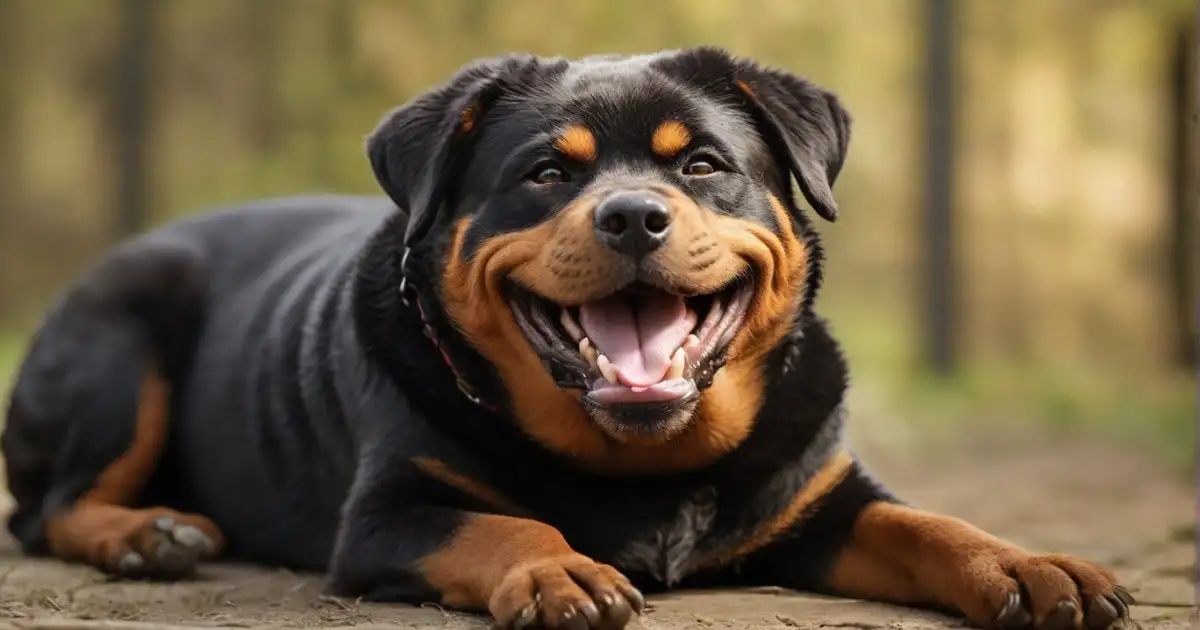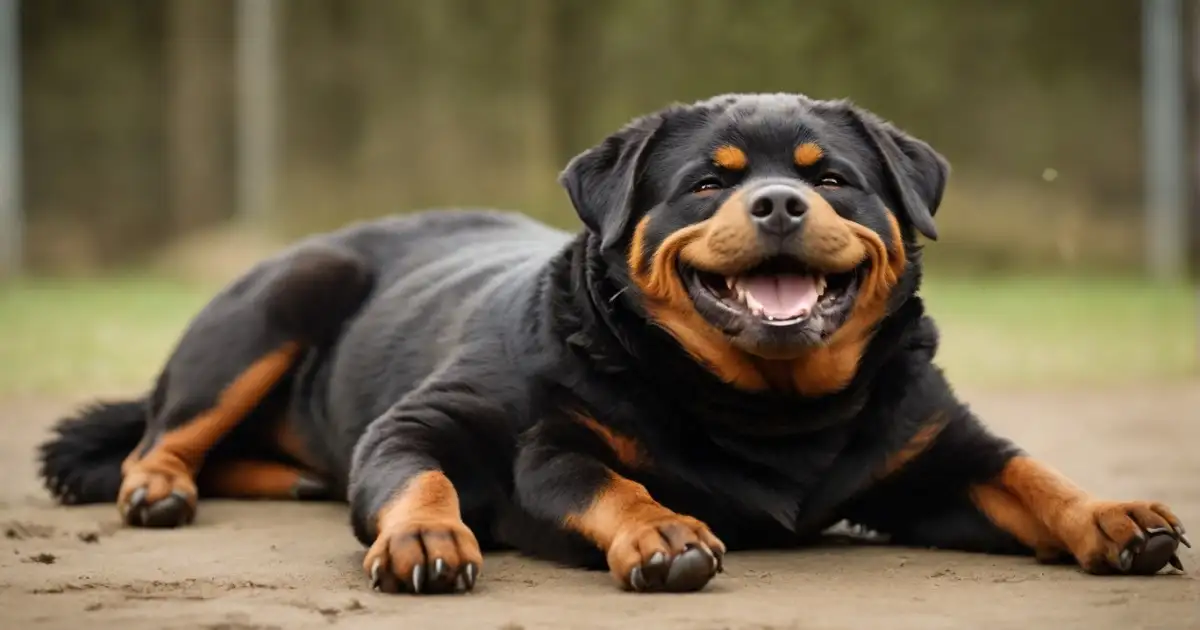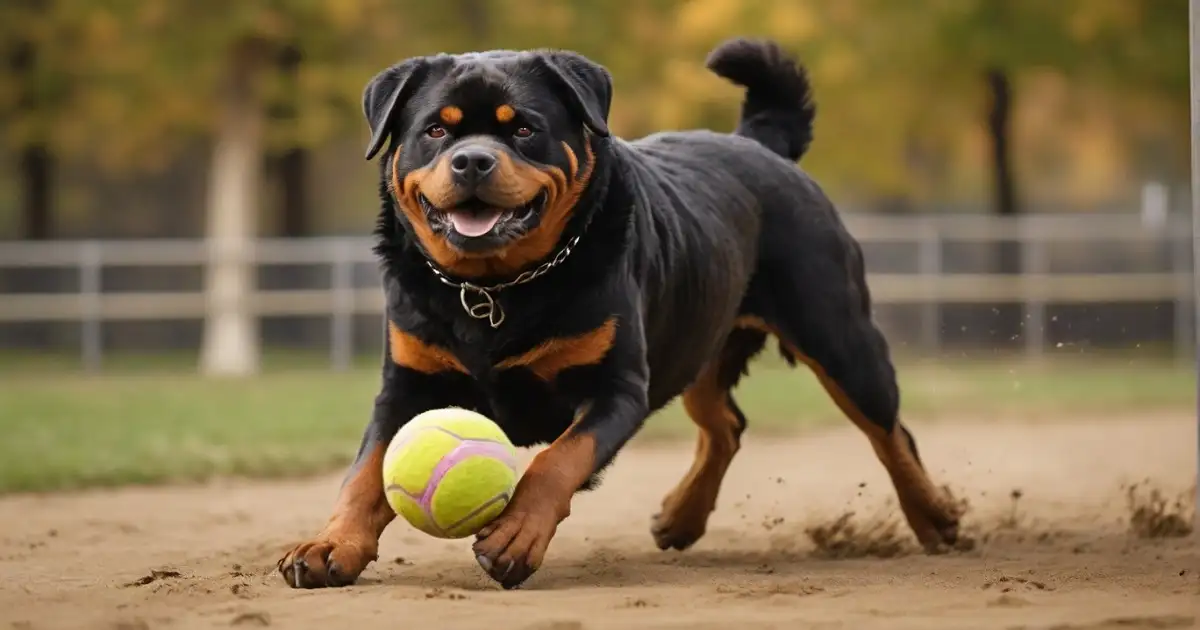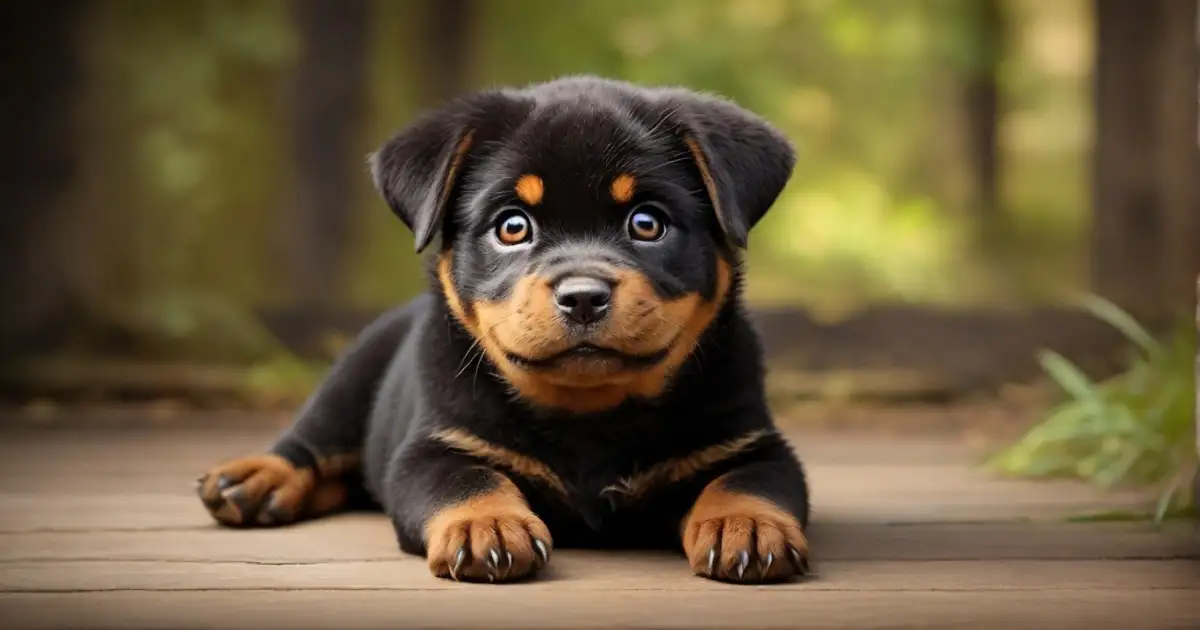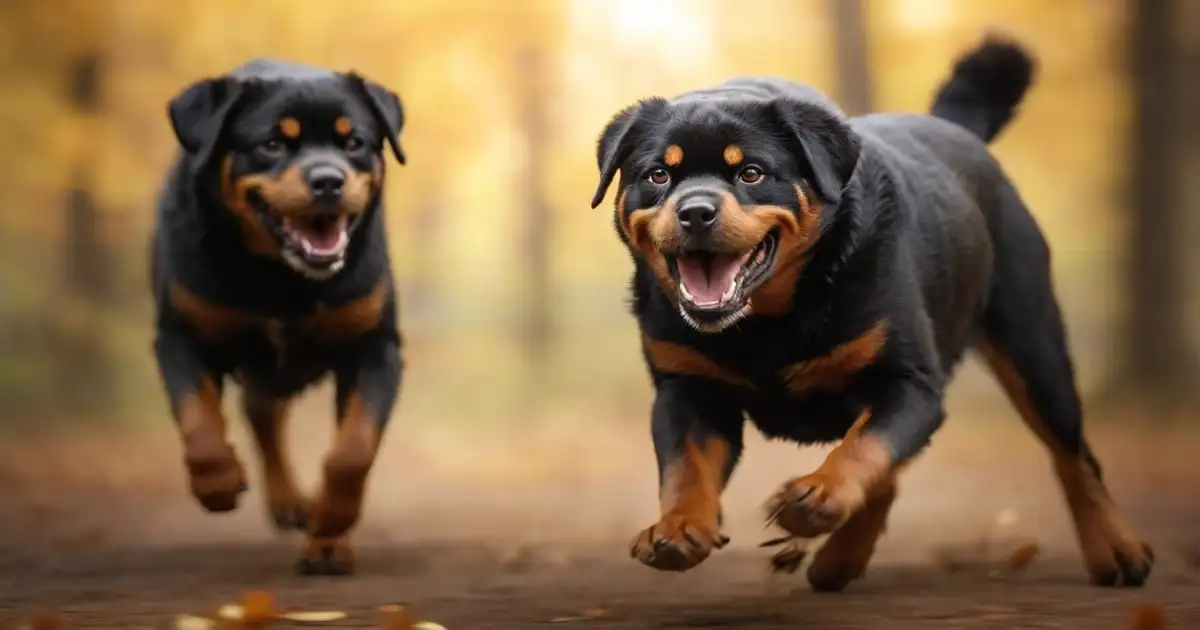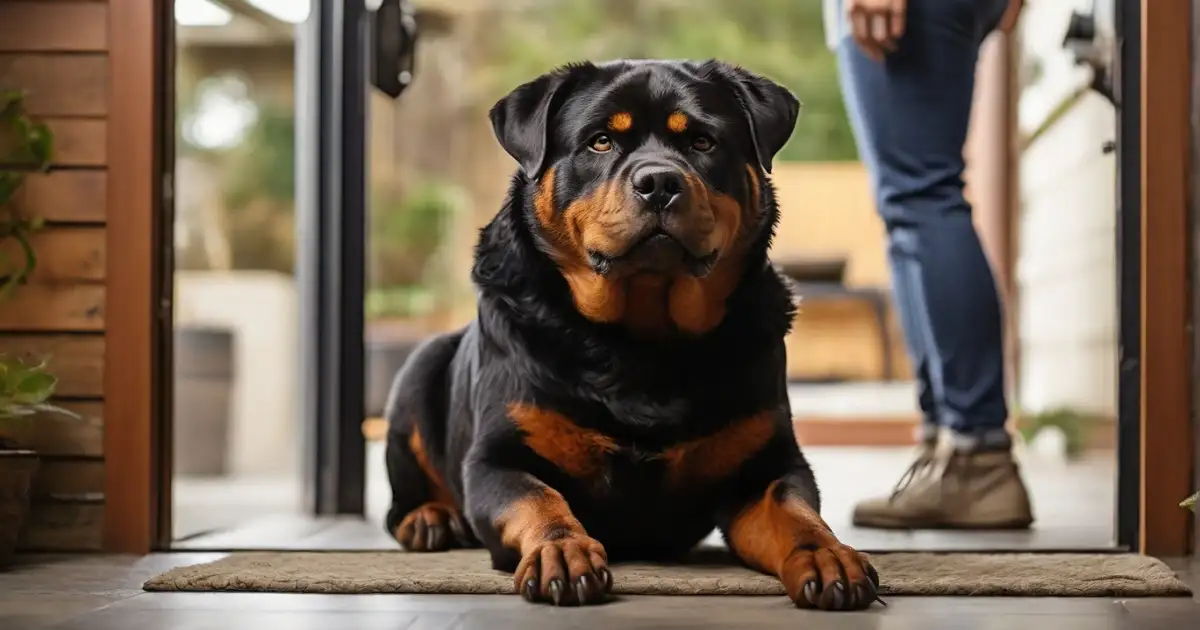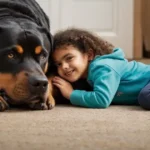Well, slap me thrice and hand me to me, mama; behaviors of a happy Rottweiler ain’t always obvious to the unlearned eye.
But have no fear, this down-home guide’s gone and rustled up all manner of handy info for identifyin’ when your pooch is pleased as punch.
From tongue-lollin’ tail wags to soft puppy dog eyes, we’ll highlight the giveaways that your Rottweiler’s happier than a hog in slop.
And if your fuzzy friend’s got a face that only his mama could love? We’ve gotcha covered on what behaviors signal an unhappy hound.
So settle on back and get ready to learn all there is to know ’bout behaviors of a happy Rottweiler!
Reading Your Rottweiler’s Body Language of Behaviors Of A Happy Rottweiler
A dog’s body and face can speak volumes if you know what signs to watch. When it comes to the behaviors of a happy Rottweiler, start by looking at that adorable mug and checking for a relaxed appearance.
- Relaxed Eyes and Forehead: When content, a Rottweiler’s eyes will be soft and loose without tension or stress. Their forehead will be smooth, too, not all scrunched and furrowed. If their eyes are bright and their forehead free of wrinkles, that’s a good indication your pup is pleased as punch.
- Upright Ears: Rottweiler ears that are pointed upwards or forwards convey happiness and confidence. Ears that are flattened back against the head can mean a dog is feeling fearful or anxious. So perky, upright ears are what you want to see.
- Wagging Tail: A tail wagging excitedly back and forth shows a dog is in a positive mood. Rottweilers specifically tend to wag more loosely from the hips when content. A loose, energetic wag is ideal over a stiff, rapid motion.
- Relaxed Jaw and Mouth: There shouldn’t be tension in the jaw of a happy Rottie. You may notice some gentle panting, which is normal. However, excessive drooling could signal stress or anxiety. A nice, easy jawline is best.
Paying attention to body language provides insight into how your Rottweiler is feeling. When his eyes, ears, tail and muzzle look relaxed, it’s a sure sign your pup is happy and healthy!
Personality Traits of a Happy Rottweiler
Beyond body language, the personality and behaviors of a happy Rottweiler reveal a lot about their well-being. Here are some key traits to look for in a satisfied pup.
- Curiosity and Playfulness: Rottweilers are a naturally inquisitive breed. A happy Rottie will be eager to explore new surroundings and show interest in any unusual objects you bring home. You can also gauge their contentment through their desire to play. Initiating games by bringing toys to you, playing, bowing, and jumping around all demonstrate that your pup is in good spirits.
- Calm and Obedient Nature: Though energetic, a well-adjusted Rottweiler will be peaceful and compliant. They should feel relaxed in public settings and when meeting new people. Following basic commands and respecting authority comes naturally to them as well. Watch for obedient behavior on walks and in training scenarios.
- Sociable with Other Dogs: Happy Rottweilers are very social animals despite their imposing looks. Your dog should feel comfortable playing with others at the dog park and meeting new canine pals. Lack of aggression towards other dogs is an excellent sign.
- Lack of Anxiety or Separation Issues: Rottweilers prone to anxiety may bark, whine or destroy things when left alone. They could also exhibit clingy behavior and distress when you return after an absence. The happier the dog, the more independent and less anxious they will be.
- Confident Posture and Demeanor: A content Rottweiler moves through life with boldness and self-assurance. You’ll notice they hold their head high, stand tall, and walk purposefully. Timid, cowering or hiding behaviors should not be present.
Watch for these personality cues to determine if your pup’s got that happy-go-lucky attitude!
Behavioral Signs of an Unhappy Rottweiler
While we all want our pups to be happy, it’s important to recognize when a Rottweiler is unhappy based on their behavioral signs. Here are key differences to look for compared to a content canine.
Differences in Body Language
- Tensed Facial Muscles– An anxious or stressed Rottweiler may have tightness around the eyes, mouth and jaw. Lip licking and yawning outside of tiredness are other distress indicators.
- Lowered Tail– Rather than an upright, wagging tail, an unhappy Rottie’s tail will tuck under, wag stiffly or point down. Ears will also flatten back.
- Avoided Eye Contact– Dogs who feel threatened or scared may turn their heads or avert their gaze to avoid visual contact.
Aggression and Reactivity
- Baring Teeth– Growling, snarling, or biting are aggressive behaviors in an unhappy dog that feels insecure or territorial.
- Lunging/Barking– Rottweilers who lunge, pull and bark aggressively on walks display reactivity from stress.
- Fighting– Getting into tussles or outright fights with other dogs is a straightforward signal of unhappiness.
Destructive Behaviors
- Chewing/Digging– When left alone, anxious dogs may use destructive chewing or dig compulsively.
- Excessive Barking– Unhappy pups are more likely to bark and howl for long periods when alone.
Lethargy and Despondency
- Disinterest– A depressed dog may lose interest in walks, toys and food – things that used to bring them joy.
- Excessive Sleep– Sleeping for very prolonged periods can indicate psychological distress.
- Avoidance– Hiding under furniture and avoiding human interaction indicates an unhappy pooch.
Knowing these common behavioral signs will help you identify if your Rottweiler is struggling with stress or anxiety so you can address the root cause.
Tips for Keeping Your Rottweiler Happy
Now that you can identify the behavioral signs of a happy Rottweiler let’s discuss tips for keeping your furry friend feeling their best.
Regular Exercise
- Rottweilers need substantial exercise daily, including long walks and active play.
- Hiking, swimming, and playing fetch are great ways to meet their needs.
- Mental stimulation through obedience, agility or scentwork is also recommended.
Positive Reinforcement Training
- Reward-based training strengthens the bond between dog and owner.
- Use praise, treats and toys to motivate them during training sessions.
- Avoid punishment or scolding, which can create distrust.
Proper Socialization
- Gradually introduce your Rottweiler to new places, people, and other dogs, starting as a puppy.
- Well-socialized dogs are more confident and less prone to reactivity.
- Arrange regular play dates with friend’s dogs.
High-Quality Diet
- Provide a nutritious diet with protein, healthy fats, vitamins and minerals.
- Avoid filler ingredients that lack proper nutrition.
- Monitor weight, adjusting food amounts as needed.
Sufficient Companionship
- Rottweilers thrive when their people are around often.
- Consider a doggy daycare or a dog walker if you are away for long hours.
- Greet your pup happily when returning home.
Following these tips will help maintain your Rottweiler’s happiness and exemplify those ideal behavioral signs of a content canine companion! Let me know if you need any clarification or have additional questions.
The Takeaway on Happy Rottweiler Behaviors
In closing, identifying the behavioral signs of a happy Rottweiler will help you better understand your loyal companion. By watching for certain body language cues, personality traits and behaviors, you can tell when your pup is pleased versus when something is amiss.
Here are some key takeaways:
- Happy Rottweilers exhibit calm, relaxed body language – loose tail wags, upright ears, soft eyes, and tension-free jaws. These all indicate contentment.
- Personality-wise, they are curious, playful, confident, and eager to socialize. Obedience and lack of separation anxiety are also positive traits.
- Unhappy Rottweilers display the opposite signals – flattened ears, lowered tails, lethargy, or aggression like bared teeth.
- Stress behaviors such as destruction, excessive barking, and reactivity on walks may manifest in displeased dogs.
- Ensuring proper exercise, training, socialization, and nutrition keeps Rottweilers happy and displays those ideal behavioral signs we love.
The more you understand your Rottweiler’s unique communication style, the better you can provide for their needs.
While individual dogs may vary, these common indicators give you a helpful blueprint. Feel free to refer to this guide anytime you need a refresher on recognizing the behavioral signs of a happy Rottweiler!

